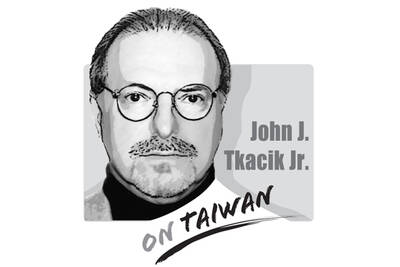While the world may never know whether the Chinese Wuhan Coronavirus originated from deliberate or accidental activities in a Chinese biological laboratory, the Chinese Communist Party (CCP) dictatorship is callously exploiting the “China Virus” as a weapon to extend its military control from the First Island Chain to the Second Island Chain.
As most of the world reeled from the toll in lives and the economic dislocations from lockdowns, the CCP has exploited these distractions by increasing its People’s Liberation Army (PLA) activities in the First Island Chain, which extends from Japan through the Ryukyus, Taiwan and the Philippines, and in the more distant Second Island Chain that extends from Japan down through Guam.
The CCP’s goal is to impose PLA control over both island chains and over the northern half of the South China Sea. This will not only isolate Taiwan, advancing conditions to promote its surrender or invasion, but it will force Japan and South Korea to reconsider their American military alliances. It will also open PLA power projection routes to the South Pacific, then Latin America, and to the Indian Ocean, Persian Gulf, and Africa, reinforcing political-economic power building networks like the Belt and Road Initiative (BRI).

A recent escalation in PLA coercive military activities in the South China Sea and near Taiwan has been the beginning of “Joint Force” operations, a high-priority goal for this most recent phase of PLA modernization. In February 2019, the South China Morning Post reported on PLA joint-force exercises in the South China Sea that may have simulated coordination between the PLA Navy, PLA Air Force, and the anti-ship ballistic missiles (ASBMs) of the PLA Rocket Force.
Then in early July 2019 multiple US outlets reported that the PLA Rocket Force fired multiple ASBMs, most likely DF-21D missiles, into the South China Sea. This demonstrates some PLA confidence in collating multiple satellite, air, and ship-borne sensors to target the estimated 1,700km-range missiles. This is now complemented by the 4,000km-range DF-26 ASBM that can reach naval targets as far as Guam, or throughout most of the Second Island Chain.
Joint force cooperation is also a recent feature of PLA coercive operations near Taiwan. On April 10, 2020, Taiwan’s Ministry of National Defense reported that the PLA sent an integrated aerial group of H-6 bombers, J-11 fighters, and KJ-500 airborne warning and control system (AWACS) aircraft through the Bashi Strait south of Taiwan. That same day the Japanese Ministry of Defense reported that a PLA Navy aircraft carrier battle group led by the carrier Liaoning had passed through the Miyako Strait to sail by the east coast of Taiwan — beyond the First Island Chain.
Also on April 10, Chinese state organ the Global Times stated, “the drills were a part of preparations for the potential military struggle against the island of Taiwan, and such drills have become regular and routine.” But they are not “routine,” they are active military preparations for the blockade and invasion of Taiwan and they will intensify.
It can be expected that PLA joint force exercises around Taiwan will soon feature regular demonstrations of ASBM strikes, coordinated with PLAAF integrated H-6 bomber strike groups and PLA Navy aircraft carrier battle groups. These joint force exercises will stress operations that threaten Taiwan from the East, to force a dispersal of Taiwan’s defensive forces, weakening anti-invasion capabilities in the West, and to create battle lines to deter the United States from coming to Taiwan’s assistance.
To secure the Second Island Chain, the PLA is now developing and deploying new theater strike systems that can extend out beyond 5,000 kilometers. For example, the PLA Air Force is now deploying its H-6N bomber, featuring an aerial refueling probe which, when combined with multiple aerial refuelings, extends the bomber’s range well beyond 5,000km. With its estimated 1,000km range air-launched ballistic missile, or its 1,500km range land attack cruise missiles, the H-6N can handily threaten US naval and air forces based in Hawaii.
The DF-26 may now equip three PLA Rocket Force brigades and may soon have a version equipped with a Hypersonic Glide Vehicle (HGV) warhead that may extend its range by over 40 percent, meaning it can reach Wake Island, which the US is considering as a “fall back” position from Guam. In addition, ASBMs will soon equip large PLA combat ships, meaning the Second Island Chain could be secured with combined ship-launched ASBMs, H-6N air-launched ASBMs, and the DF-26 ASBMs reaching out to Wake Island.
To meet this threat, the United States, its allies, and partners have little choice but to make maximum use of their current possession of the First Island Chain to ensure the destruction of all PLA forces responsible for aggression near or beyond it. For example, at the end of March, Japan completed the deployment of new defensive anti-aircraft missiles to Miyakojima Island in the Southern Ryukyus, about 350km from Taiwan.
But in an April 5, 2020 interview in Japan’s Asahi Shimbun, Obama Administration former Deputy Assistant Secretary of Defense for Nuclear and Missile Defense Policy Brad Roberts suggested that considering new PLA “anti-access” capabilities, Japan should have a “strike capability,” perhaps new long range missiles, to complement new US missile strike capabilities.
It is also necessary for Washington to extend this logic to Taiwan. The Trump Administration is already rapidly developing new medium (500km) range and intermediate (3,000 to 5,500km) range ballistic and anti-ship ballistic missiles, and air-launched hypersonic missiles. In addition to offering some of these, the US should offer to sell to Taiwan low-cost used KC-135 tanker aircraft to extend the range of Taiwan’s fighters and patrol aircraft, to counter PLA joint operations well out into the Second Island Chain.
After President Harry Truman ordered the US Navy 7th Fleet to patrol the Taiwan Strait following the 1950 North Korean invasion of South Korea, General Douglas MacArthur would call Taiwan “an unsinkable aircraft carrier.” It is now necessary for Taipei, Tokyo and Washington to prevent Taiwan from becoming the CCP’s unsinkable carrier, assuring its control over the First and Second Island Chains.
Richard D. Fisher, Jr. is a senior fellow with the International Assessment and Strategy Center.
You wish every Taiwanese spoke English like I do. I was not born an anglophone, yet I am paid to write and speak in English. It is my working language and my primary idiom in private. I am more than bilingual: I think in English; it is my language now. Can you guess how many native English speakers I had as teachers in my entire life? Zero. I only lived in an English-speaking country, Australia, in my 30s, and it was because I was already fluent that I was able to live and pursue a career. English became my main language during adulthood

Somehow, US intelligence identified “the Houthis’ top missile guy” and pinpointed his exact location. At 1348 hours (Washington time), March 15, President Trump’s national security advisor Mike Waltz texted, “positive ID of him walking into his girlfriend’s building.” The unsuspecting Romeo entered. High above, the drone monitoring the building registered a flash. When the smoke cleared, Mr. Waltz texted, “…And it’s now collapsed.” RIP. The star-crossed “top missile guy” had been target number one in the now uproarious US Navy bombing campaign on that Sunday against the Yemeni rebels who have been holding the Red Sea hostage since October 19,
Taiwan on Monday celebrated Freedom of Speech Day. The commemoration is not an international day, and was first established in Tainan by President William Lai (賴清德) in 2012, when he was mayor of that city. The day was elevated to a national holiday in 2016 by then-president Tsai Ing-wen (蔡英文). Lai chose April 7, because it marks the anniversary of the death of democracy advocate Deng Nan-jung (鄭南榕), who started Freedom Era Weekly to promote freedom of expression. Thirty-six years ago, a warrant for Deng’s arrest had been issued after he refused to appear in court to answer charges of
The Opinion page has published several articles and editorials over the past few weeks addressing Taiwan’s efforts to leverage unique or strong aspects of its culture to increase international awareness of the nation. These have included submissions by foreign journalists and overseas students, highlighting how bubble milk tea, Guinness World Record attempts, the entertainment sectors, impressive scenery, world-class cuisine and important contributions to the high-tech supply chain can enhance Taiwan’s recognition overseas and therefore its soft power. That entails competing for attention in already crowded sectors. Other nations, after all, offer popular entertainment exports, beautiful scenic spots and great food.